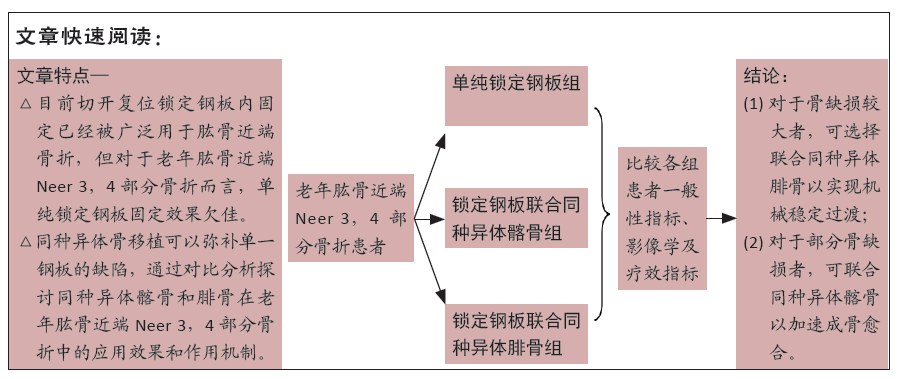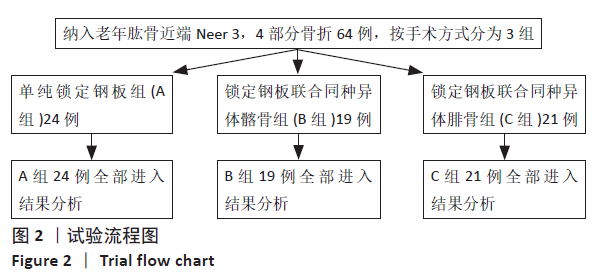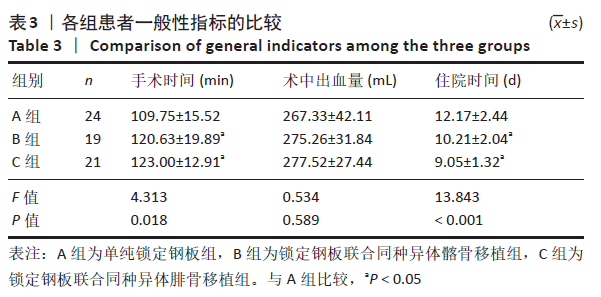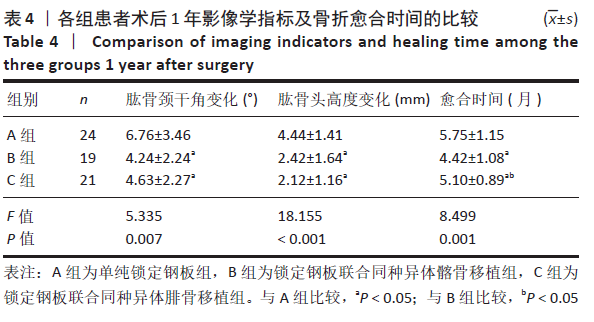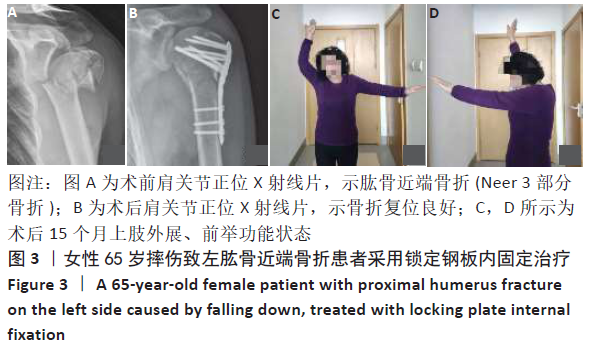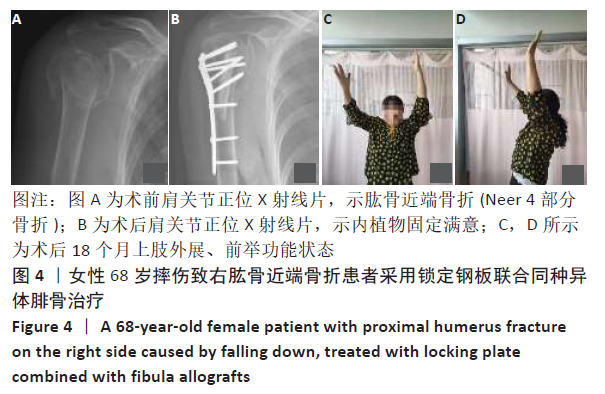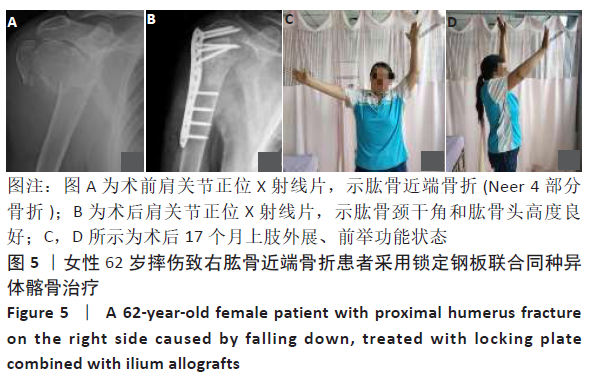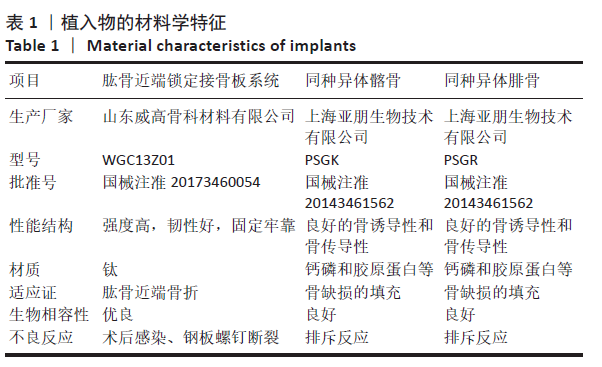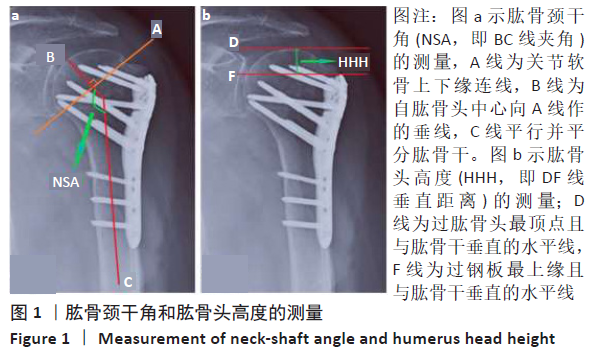[1] ROUX A, DECROOCQ L, EL BATTI S, et al. Epidemiology of proximal humerus fractures managed in a trauma center. Orthop Traumatol Surg Res. 2012;98(6):715‐719.
[2] WARRINER AH, PATKAR NM, CURTIS JR, et al. Which fractures are most attributable to osteoporosis? J Clin Epidemiol. 2011;64(1):46‐53.
[3] HOWARD L, BERDUSCO R, MOMOLI F, et al. Open reduction internal fixation vs non-operative management in proximal humerus fractures: a prospective, randomized controlled trial protocol. BMC Musculoskelet Disord. 2018;19(1):299.
[4] ANTONIOS T, BAKTI N, NZEAKO O, et al. Outcomes following fixation for proximal humeral fractures. J Clin Orthop Trauma. 2019;10(3):468‐473.
[5] 王林祥,王兵,赵滨,等.肱骨近端骨折的治疗进展[J].中国老年学杂志, 2017,37(2):489-491.
[6] CAMPOCHIARO G, REBUZZI M, BAUDI P, et al. Complex proximal humerus fractures: Hertel’s criteria reliability to predict head necrosis. Musculoskelet Surg. 2015;99 Suppl 1:S9-S15.
[7] JABRAN A, PEACH C, REN L. Biomechanical analysis of plate systems for proximal humerus fractures: a systematic literature review. Biomed Eng Online. 2018;17(1):47.
[8] BIERMANN N, PRALL WC, BÖCKER W, et al. Augmentation of plate osteosynthesis for proximal humeral fractures: a systematic review of current biomechanical and clinical studies. Arch Orthop Trauma Surg. 2019;139(8):1075‐1099.
[9] LEE SJ, HYUN YS, BAEK SH. Strut Support with Tricortical Iliac Allografts in Unstable Proximal Humerus Fractures: Surgical Indication and New Definition of Poor Medial Column Support. Clin Shoulder Elb. 2019;22(1):29-36.
[10] ZHAO L, QI YM, YANG L, et al. Comparison of the Effects of Proximal Humeral Internal Locking System (PHILOS) Alone and PHILOS Combined with Fibular Allograft in the Treatment of Neer Three- or Four-part Proximal Humerus Fractures in the Elderly. Orthop Surg. 2019;11(6):1003‐1012.
[11] 张军,庄云强,李东贞,等.锁定钢板结合异体腓骨支撑治疗老年肱骨近端Neer三、四部分骨折[J]. 中华创伤骨科杂志,2018,20(11):946-952.
[12] 邢飞,段鑫,刘明,等.同种异体腓骨移植联合锁定钢板治疗肱骨近端骨折的研究进展[J]. 中国修复重建外科杂志,2020,34(2):260-265.
[13] NEER CS 2ND. Displaced proximal humeral fractures.I. Classification and evaluation.J Bone Joint Surg(Am). 1970;52(6):1077-1089.
[14] CONSTANT CR, MURLEY AH. A clinical method of functional assessment of the shoulder. Clin Orthop Relat Res. 1987;(214):160-164.
[15] HELLER GZ, MANUGUERRA M, CHOW R. How to analyze the Visual Analogue Scale: Myths, truths and clinical relevance. Scand J Pain. 2016;13:67-75.
[16] 章宁杰,蒋凌,周祖彬,等.锁定钢板治疗Neer3、4部分肱骨近端骨折的病例对照研究[J].中国骨伤,2014,27(1):38-40.
[17] JABRAN A, PEACH C, REN L. Biomechanical analysis of plate systems for proximal humerus fractures: a systematic literature review. Biomed Eng Online. 2018; 17(1):47.
[18] STONE MA, NAMDARI S. Surgical Considerations in the Treatment of Osteoporotic Proximal Humerus Fractures. Orthop Clin North Am. 2019;50(2):223-231.
[19] CARBONE S, PAPALIA M. The amount of impaction and loss of reduction in osteoporotic proximal humeral fractures after surgical fixation. Osteoporos Int. 2016;27(2):627-633.
[20] 李建文,杨永博,万蕾,等.3D技术辅助下半肩置换治疗中老年肱骨近端粉碎性Neer Ⅳ型骨折[J].中国骨伤,2019,32(9):810-814.
[21] 王炳,朱诚,王平,等.术后初次颈干角对锁定钢板治疗肱骨近端骨折疗效的影响[J].中国骨伤,2018,31(9):794-798
[22] BARLOW JD, LOGLI AL, STEINMANN SP, et al. Locking plate fixation of proximal humerus fractures in patients older than 60 years continues to be associated with a high complication rate. J Shoulder Elbow Surg. 2020;29(8):1689-1694.
[23] ROBINSON CM, STIRLING PHC, GOUDIE EB, et al. Complications and Long-Term Outcomes of Open Reduction and Plate Fixation of Proximal Humeral Fractures. J Bone Joint Surg Am. 2019;101(23):2129-2139.
[24] 向成浩,王诗波,明玉祥.内侧柱支撑重建结合锁定钢板内固定治疗老年肱骨近端骨折的临床疗效[J].中国矫形外科杂志,2015,23(4):289-294.
[25] LEE SH, HAN SS, YOO BM, et al. Outcomes of locking plate fixation with fibular allograft augmentation for proximal humeral fractures in osteoporotic patients: comparison with locking plate fixation alone. Bone Joint J. 2019;101-B(3): 260-265.
[26] CUI X, CHEN H, MA B, et al. Fibular strut allograft influences reduction and outcomes after locking plate fixation of comminuted proximal humeral fractures in elderly patients: a retrospective study. BMC Musculoskelet Disord. 2019;20(1):511.
[27] CHEN H, YIN P, WANG S, et al. The Augment of the Stability in Locking Compression Plate with Intramedullary Fibular Allograft for Proximal Humerus Fractures in Elderly People. Biomed Res Int. 2018;2018:3130625.
[28] MYERS DM, TRIPLET JJ, WARMOTH PJ, et al. Improved Outcomes Using a Fibular Strut in Proximal Humerus Fracture Fixation. Orthopedics. 2020;43(5):262-268.
[29] RUSIMOV L, ZDERIC I, CIRIC D, et al. Does Supplemental Intramedullary Grafting Increase Stability of Plated Proximal Humerus Fractures?. J Orthop Trauma. 2019;33(4):196-202.
[30] HSIAO CK, TSAI YJ, YEN CY, et al. Intramedullary cortical bone strut improves the cyclic stability of osteoporotic proximal humeral fractures. BMC Musculoskelet Disord. 2017;18(1):64.
[31] TUERXUN M, TUXUN A, ZENG L, et al. Locking Plate Combined With Endosteal Fibular Allograft Augmentation for Medial Column Comminuted Proximal Humeral Fracture. Orthopedics. 2020;43(6):367-372.
[32] 杜辉,付勤.同种异体骨移植与自体骨移植修复四肢粉碎性骨折:骨性愈合及骨活性比较[J].中国组织工程研究,2015,19(8):1206-1210.
[33] WANG W, YEUNG KWK. Bone grafts and biomaterials substitutes for bone defect repair: A review. Bioact Mater. 2017;2(4):224-247.
[34] 王传舜,李豪青,伍凯,等.肱骨近端锁定接骨板结合异体骨植骨治疗外翻嵌插型四部分肱骨近端骨折[J].中华创伤骨科杂志,2013,15(10):909-911.
[35] PANCHAL K, JEONG JJ, PARK SE, et al. Clinical and radiological outcomes of unstable proximal humeral fractures treated with a locking plate and fibular strut allograft. Int Orthop. 2016;40(3):569-577.
[36] ROBERTS TT, ROSENBAUM AJ. Bone grafts, bone substitutes and orthobiologics: the bridge between basic science and clinical advancements in fracture healing. Organogenesis. 2012;8(4):114-124. |
